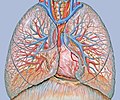Previously, Grikscheit’s lab developed tissue-engineered small intestine (TESI) and showed that this regenerated tissue was functional and contained all of the key components of the native tissue. The Grikscheit lab employed a similar strategy to recapitulate the human lung and trachea, transplanting stem and progenitor cells on biodegradable polymer scaffolds. The tissue that grows from this strategy is termed tissue-engineered lung or TELu.
Transplanting regionally specific lung tissue (proximal or distal) from mice and humans generates TELu with typical location-specific tissue markers such as particular alveolar or air sac cells in the distal TELu or tracheal epithelial cells organized with cartilage and ciliated appendages for proximal lung. TEtrach, or tissue-engineered trachea, grew from the most proximal cells.
“We think that understanding lung regeneration in this model will allow several steps forward,” said Grikscheit, who is also a tenured associate professor of Surgery at the Keck School of Medicine of the University of Southern California. “For example, advanced stages of disease can be studied with TELu that would be impossible to fully understand in our patients. Likewise,we can more quickly apply many more therapies in this model in order to – hopefully – deliver future human therapies.”
Additional contributors include Andrew Trecartin, MD, Soula Danopoulos, PhD, Ryan Spurrier, MD,
Hanaa Knaneh-Monem, PhD, Michael Hiatt, PhD, and Barbara Driscoll, PhD, all of CHLA; and Christian Hochstim, MD, PhD, and Denise Al-Alam, PhD, of CHLA and Keck School of Medicine of USC.
This project was funded in part by the European Union’s Horizon 2020 research and innovation program and the American Heart Association.
About Children’s Hospital Los Angeles
Children's Hospital Los Angeles has been named the best children’s hospital in California and among the top 10 in the nation for clinical excellence with its selection to the prestigious U.S. News & World Report Honor Roll. Children’s Hospital is home to The Saban Research Institute, one of the largest and most productive pediatric research facilities in the United States. Children’s Hospital is also one of America's premier teaching hospitals through its affiliation since 1932 with the Keck School of Medicine of the University of Southern California. For more information, visit CHLA.org. Follow us on Twitter, Facebook, YouTube and LinkedIn, or visit our blog at http://researchlablog.org/.
Media contact: Debra Kain, dkain@chla.usc.edu , 323-361-7628
